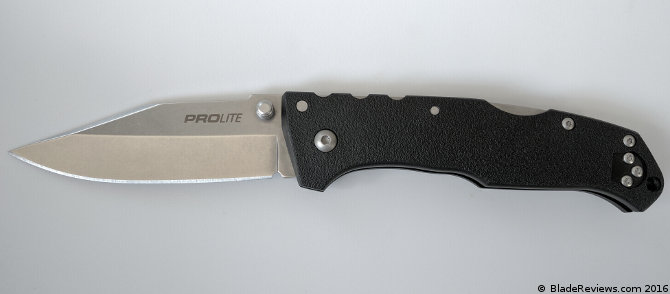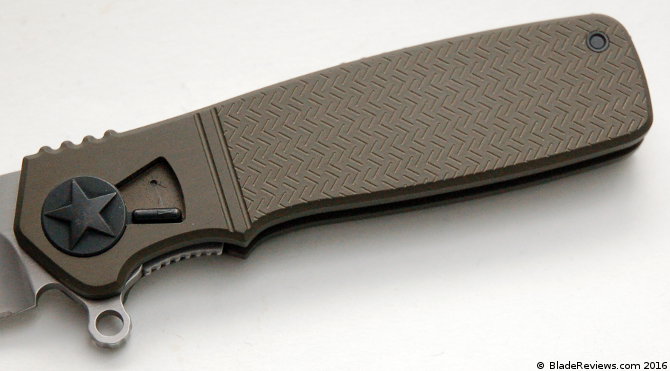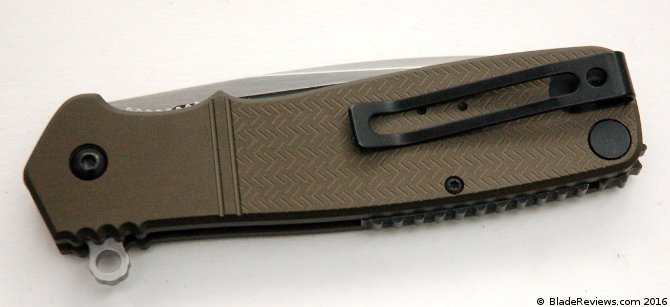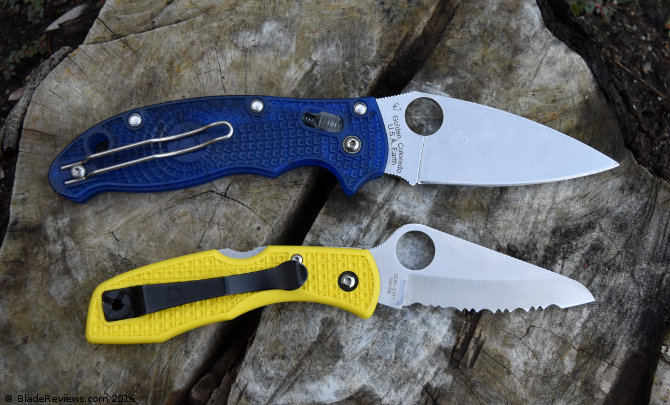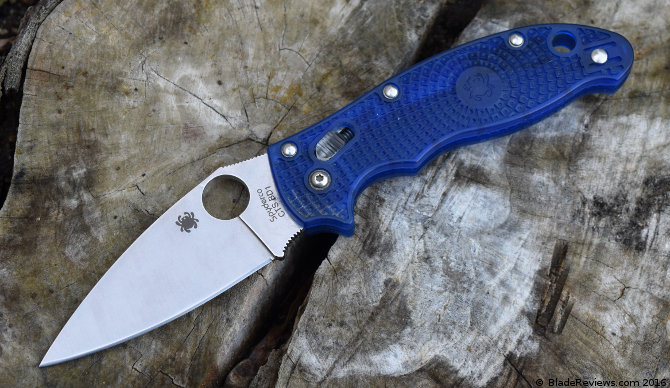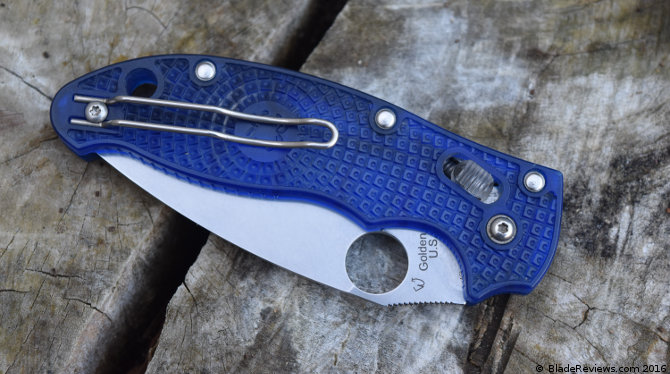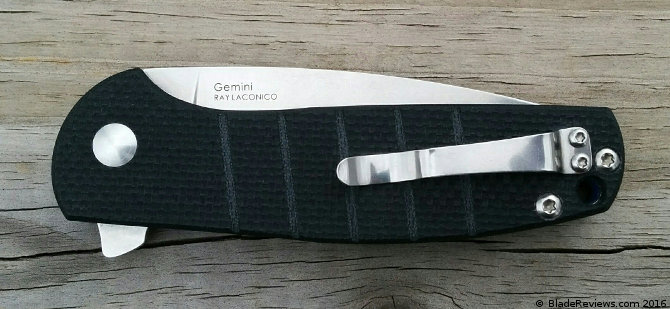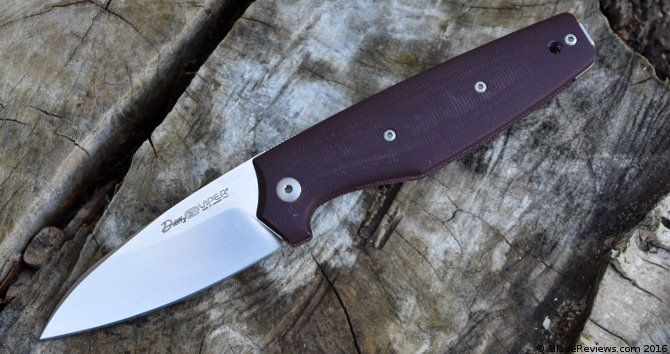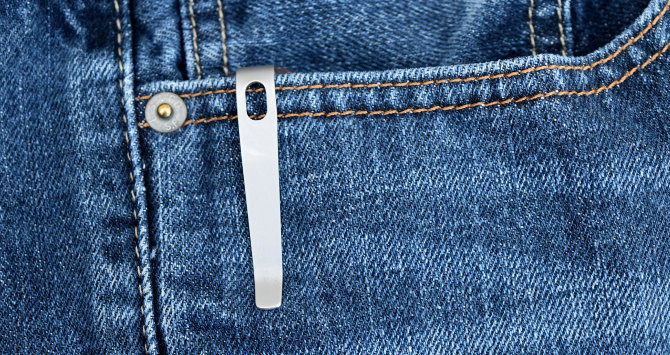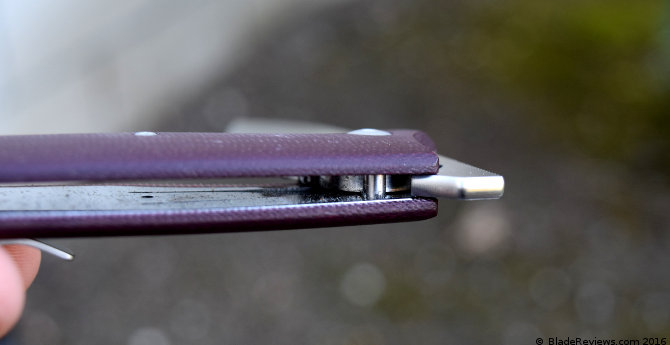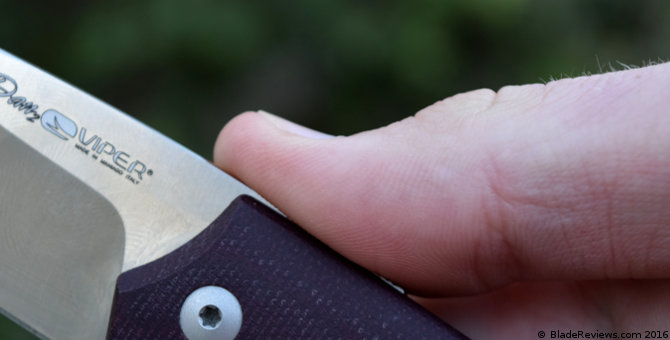Last Updated: August 30, 2019
Admittedly, the Mantra 1 had a hill of biases to climb from the start with me. It is a titanium frame lock flipper, a style of knife that I’ve never warmed up to. I find the flipper to be an inferior deployment method for knives, and while I’ve had positive experiences recently with the frame lock, unless it is done exceptionally well it’s temperamental nature make it a sub-optimal lock for daily use.

Buy the Spyderco Mantra 1 at BladeHQ
There was also the Mantra’s heritage to consider: it is more or less a retooled Delica 4. I like the Delica as it exists in knife community mythology: an affordable, ideal EDC blade, a true classic that anyone can afford. I enjoy the reality of the Delica much less: strange ergonomics, underwhelming VG-10 steel, and a just-slightly-too-high price point have made it hard for me to connect with this venerable blade.
So I picked up the Mantra 1 to see if it could prove itself worthy, both as a titanium framelock flipper, and as a reimagining of the Delica chassis.
And there are many ways in which the Mantra is a fine tool. But it has completely bounced off me. The Mantra is a safe design. Too safe. Not every knife needs to be a history-making masterpiece, but nothing about the Mantra’s design excites me. It is purely perfunctory, a competent knife, but a complacent design. Worse, there are things about it that drove me crazy from day one. The longer I carried the Mantra, the more I noticed major problems with its form, its function, and its purpose. Carrying it was never a chore, but it never distinguished itself in use, and now that it’s out of my pocket I can’t imagine why I’d ever carry it again.
General Dimensions and Blade Details
The Mantra has a handle length of 4”, a blade length of 3 1/8”, and an overall length of 7 ¼” and is made in Taiwan. It weighs 3 oz. As a modified Delica 4, it is a little bigger, and a little heavier.
The leaf shape blade is a workhorse. The additional cutting edge length and blade width over a Delica makes a difference when it comes to slicing. The Mantra’s blade is precise and efficient without being overlarge or cumbersome. The ergonomics mess with the cutting control somewhat, but the blade shape itself is pure gold.

The steel is my first big issue with the Mantra. I will never disparage CPM-M4’s sheer cutting ability. This is a knife that takes a sharp edge, holds it forever, and is tough, tough, tough. I liked its performance on my Air and I like it here on the Mantra – but when I’m not cutting with M4, I hate it.
M4 is not a stainless steel. It discolors, tarnishes, and stains with little provocation, and quite quickly. The minute I got my Mantra I wiped it down with oil, and even so every time I touched the blade my fingers left a mark. I left the Mantra out overnight on my desk in an air-conditioned apartment, and there was discoloration all over the next morning. If the Mantra was designed to be a true everyday user, M4 was a bad choice. I don’t want to have to baby and fret over my EDC knife; it should work well and virtually maintain itself.
I feel like Spyderco knows that M4 has a corrosion problem, because the Mantra’s flipper tab, ostensibly the place that will be receiving the most contact from your finger, is differently finished, almost polished, as if to counteract that additional contact – and it still discolors. If Spyderco wanted to go with M4 here, they should have coated or clad it. The sprint run HAP40 Delicas have a laminated blade to fight corrosion, and HAP40 actually has more chromium than M4, so I don’t know why they didn’t work to combat M4’s weaknesses on this more expensive knife.

M4 is a great steel for specialized applications, but its quirks preclude it from being an all-purpose folding knife steel. If it was the only steel in the world with great edge retention and toughness, that would be one thing, but we are literally spoiled for choice when it comes to super steels available on $150-200 knives. S35VN is not a ridiculous thing to ask for at $160, and it would have been perfect here. My suspicion is that we are seeing M4 on the Mantra for the same reason that we are still seeing a lot of Spyderco knives with S30V: they have a lot of the stuff lying around and need to get rid of it. But whether it was a matter of convenience or Spyderco really believes in this stuff, it just doesn’t work here.
Handle, Ergonomics, and Carry
I may not love the Delica 4, but I readily acknowledge that the design has been gone over so much that nothing feels like an accident. Even the handle, which I find too prescriptive, is more refined and considered than most knives’. If there was one thing the Mantra seemed to carry over unmodified from the Delica 4, it was its handle design.

But here’s where the flipper starts to make life difficult. The Delica 4 handle may not be my favorite, but it does work. However, it needs every last centimeter of its handle length to do so. The Mantra retains the Delica 4 handle’s overall length, but doesn’t change the size to accommodate the flipper tab, which of course works as a forward guard, perpendicular to the handle, when the knife is open. What this means is that you actually lose usable handle length over the Delica.
Thus, in hand, I found the Mantra a Delica-but-less, and thus uncomfortable. The scalloping makes your pointer finger run right up against the flipper tab. You also have to stretch your thumb a bit to actually make use of the jimped thumb ramp. Holding the knife like you’re supposed to, your hand is canted at a weird angle, and strangely distant from the start of the cutting edge. You lose a lot of control.
The titanium handle scales themselves are quite nice, well-machined and chamfered, with an attractive large grain stone wash. They’re mildly textured, but positive enough grip-wise, aided by the jimping on the thumb ramp and the lockbar insert. All details that Spyderco and its Taichung facility generally get right, but the flawed fundamentals make the execution more or less moot.

The Mantra works well in the pocket. The deep carry wire clip keeps it buried and out of the way until you need it, and the scales won’t shred your pants. I have been a longtime disparager of the Spyderco wire clip, finding it a little fragile. If there’s a positive takeaway from my time with the Mantra, it’s that I was wrong about this clip. It survived weeks of carry with no problem, and actually looks handsome in its way, so I’m a semi-convert on the wire clip.
Deployment and Lockup
Judging by any standard, the Mantra’s flipper is mediocre. Despite utilizing a ball bearing pivot, it’s laggardly. It isn’t thoughtless: you have to be deliberate with your deployment motion. It misfires every once and a while. It even fails at the more frivolous things: it isn’t particularly smooth, particularly effortless, or particularly satisfying to fidget with. Ironically, the Spyder Hole works really well here, and this is a satisfying knife to flick open in the ‘traditional’ way: fast and sure.
The frame lock is good. No play, and disengagement is easy. A very scrawny-looking lock bar, but it manages to inspire confidence with its fuss-free performance.
Spyderco Mantra Review – Final Thoughts
I don’t like the Mantra. The steel choice isn’t right, the ergonomics are actually bad, and the main selling point, the flipper, is undercooked. It’s hard to make an unusable knife at the $160 price point, and Mantra does work, but its profound lack of spark, along with its flawed fundamental execution, scuttles what could be good here.
Spyderco is famous for thinking their knives through, but the Mantra feels like it’s one or two design revisions away from where it should be. There are better blades at pretty much every price point.
- material type: Synthetic
- Mantra Framelock
If you are thinking of buying a Spyderco Mantra, please consider purchasing it at Amazon or BladeHQ. Thanks for reading.


